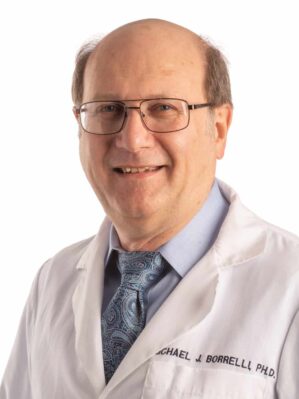Director

Michael J. Borrelli, Ph.D.
Professor, Department of Radiology
Director of Research, Department of Radiology
Associate Director, Arkansas Nanomedicine Center
Director, Molecular Imaging Core
Objectives
In most cases, delivering more drug or other therapies to diseased tissues will produce a more effective and positive therapeutic outcome. Furthermore, many treatments for cancer and other diseases have toxic side effects for normal tissues when these therapies are delivered systemically.
Targeting therapeutic delivery provides effective doses to diseased tissues while minimizing delivery to normal tissues. Hence, a targeted nanomedicine has the potential to provide more effective treatment with minimal and better tolerated side effects.
Borrelli focuses his cancer research on treatments for liver, pancreatic, and brain tumors.
His experience with ultrasound, microwaves, ionizing radiation, and lasers permits him to use these physical modalities to help target nanoparticles to diseased tissues and to help release drugs and other therapeutics from the nanoparticles within the diseased tissues to improve treatment efficacy while reducing normal tissue side effects.
Background
A recent collaboration with Ajay P. Malshe, Ph.D. — University of Arkansas — involves combining biodegradable nanoparticles with the microbubbles to improve the rate and efficacy of sonothrombolysis.
Borrelli and Dr. William Culp are also developing the use of a nanoemulsion that carries oxygen and drugs to tissues that are deprived of oxygen due to stroke. This keeps the affected brain tissues alive until the clot causing the stroke can be destroyed or removed.
Thus, residual deficits like paralysis, disorientation, memory loss, etc. will be minimized. Stroke patients will have more time to reach treatment centers and physicians will have more time to plan and execute effective stroke treatments because the oxygen-carrying emulsion will sustain the stroke-affected brain tissue in a viable state longer.
Accomplishments
Borrelli has worked with Dr. William Culp to develop the mechanism of combining microbubbles with ultrasound to lyse clots that cause stroke and myocardial infarcts. Using ultrasound with microbubbles and other agents to lyse clots is called sonothrombolysis. This line of research is also applicable to treating pulmonary embolisms, deep venous thrombosis, and other vascular occlusion diseases.
Borrelli has identified non-toxic compounds that increase tumor ablation efficacy by ultrasound, radiofrequency ablation, and irreversible electroporation. These compounds are delivered specifically to the tumors using liposomes.
Function
- The UAMS Molecular Imaging Core includes a Bruker 7 T MRI, a Siemens Focus MicroPET, and an Ultrasound Imaging System, all of which can be used to image guide delivery of nano-therapeutics to diseased tissues and to confirm that the desired dose was delivered.
- Produce microbubbles, liposomes, nanoemulsions, and other nanoparticles; and perform the bioconjugations required to attach antibodies, peptides and other molecules to the nanoparticles to help target them to diseased tissues.
- Develop and utilize image-guided, targeted delivery of drugs and other therapeutics by means of liposomes, nanoemulsions, and other nano-sized carriers.
- Targeted delivery to diseased tissues is achieved by antibodies, peptides, and other targeting molecules on the surface of the particles and/or by using ultrasound, lasers, heat, microwaves and other physical mechanisms to release the therapeutics from the nanoparticles within the diseased tissues.
- Use targeted, nanomedicine approaches to develop treatments for cancer, stroke, and cardiovascular diseases.
- Microbubbles, liposomes, nanoemulsions, and other therapeutic agents are produced in Dr. Borrelli’s laboratory.
Contact
University of Arkansas for Medical Sciences, College of Medicine
UAMS Department of Radiology
4301 West Markham Street, #556
Little Rock, AR 72205-7199
Email: mjBorrelli@uams.edu
Phone: 501-526-5897
